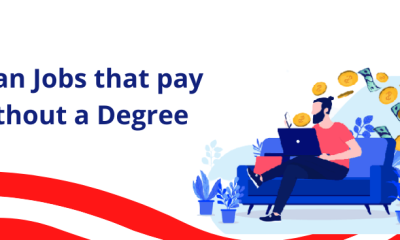Jobs
Work and Study Opportunities for Foreigners in USA: Submit Application Now
The United States remains a top destination for international students seeking high-quality education, a diverse cultural experience, and opportunities for professional growth. For many, studying in the USA is not just about academics but also about gaining real-world work experience and offsetting the costs of education. Fortunately, there are several ways for students to study and work simultaneously in the USA, provided they meet specific criteria.
In this blog post, we’ll explore some of the key pathways that allow students to pursue both education and employment in the United States.
Work and Study Opportunities for Foreigners in USA
1. On-Campus Employment
For students holding an F-1 visa, on-campus employment is one of the easiest ways to work while studying. This type of employment is:
- Permissible for up to 20 hours per week during the school term and full-time during holidays or summer breaks.
- Available to first-year international students as long as they maintain good academic standing.
- Usually positions within the campus like working in the library, cafeterias, bookstores, or as research or teaching assistants.
Many U.S. universities provide a range of on-campus job opportunities, and the experience gained often enhances a student’s academic and social experience.
2. Curricular Practical Training (CPT)
Curricular Practical Training (CPT) allows F-1 students to gain practical experience directly related to their field of study. This is particularly beneficial for those pursuing degrees in subjects that demand practical training as part of the academic curriculum.
- Eligibility: Students must have been enrolled full-time for at least one academic year.
- Work conditions: CPT can be part-time (up to 20 hours per week) during the school year or full-time during breaks. However, using full-time CPT for 12 months or more may impact eligibility for Optional Practical Training (OPT).
- Field-related employment: CPT must be an integral part of the student’s curriculum and directly related to their major.
Students usually participate in CPT through internships, cooperative education programs, or other work-study programs sponsored by their academic institutions.
3. Optional Practical Training (OPT)
Optional Practical Training (OPT) is another popular option for F-1 students seeking work experience. While OPT can be used during or after completing your degree, most students use it after graduation.
- Pre-completion OPT: Students may work part-time (up to 20 hours per week) while school is in session and full-time during vacations.
- Post-completion OPT: Students can work full-time for up to 12 months after completing their degree. For those in STEM fields (Science, Technology, Engineering, and Mathematics), there is an option to extend OPT for an additional 24 months.
- Field-related employment: Like CPT, the work must be directly related to the student’s major.
OPT allows students to work anywhere in the U.S., offering flexibility and the chance to explore job opportunities in their field.
4. Graduate Assistantships
For graduate students, assistantships are a great way to combine work and study. Universities offer various types of assistantships, including:
- Teaching Assistantships (TA): Students assist professors with teaching-related tasks like grading, leading discussions, or tutoring undergraduate students.
- Research Assistantships (RA): Students work with faculty on research projects, gaining valuable experience in their field of study.
- Administrative Assistantships (AA): Students help with administrative tasks within university departments.
In return for their work, graduate assistants often receive stipends, tuition remission, or other benefits, making this a financially attractive option.
5. Student Internships (J-1 Visa)
Students on a J-1 visa (Exchange Visitor Program) can engage in internship programs to gain practical experience in their field of study. While the J-1 visa is primarily for exchange visitors, many students use it to work as interns in U.S. companies, nonprofits, or governmental organizations.
- Internship requirements: The internship must be directly related to the student’s academic field and part of their official program of study.
- Training plans: Employers must provide a structured internship or training plan to ensure educational relevance.
- Duration: The J-1 visa allows students to engage in work or internships for the duration of their program, though specific restrictions may apply depending on the program.
6. Work-Study Programs
Some U.S. universities offer federally funded work-study programs for students with financial need, which allows them to work part-time while attending school. The work-study program is available to both undergraduate and graduate students.
- Financial need: To qualify, students must demonstrate financial need, determined by completing the Free Application for Federal Student Aid (FAFSA).
- Type of work: Jobs can be on-campus or off-campus, but they often align with the student’s course of study or serve the community.
- Hours: Like other programs, students can work up to 20 hours per week during school sessions.
7. Co-Op Programs
Some universities in the USA offer Cooperative Education (Co-op) Programs that alternate between academic semesters and full-time work placements in the student’s field of study. These programs allow students to gain in-depth work experience while earning academic credit.
- Alternating study and work terms: Co-op programs typically require students to alternate semesters of study and work. For example, a student may study for one semester and work full-time in a paid job related to their field the next semester.
- Work is integral to the degree: Co-op programs are designed as part of the academic curriculum, allowing students to apply what they learn in real-world settings.
8. Part-Time Jobs for International Students
While working off-campus is generally restricted for F-1 students, they can pursue part-time jobs under certain conditions:
- Severe Economic Hardship: Students who experience unforeseen financial difficulties can apply for authorization to work off-campus. This applies to students who have completed at least one academic year in the U.S. and demonstrate a legitimate need.
- Employment with an International Organization: F-1 students can work for recognized international organizations like the UN, IMF, or World Bank.
How to get a job as an international student in the USA?
Understanding Your Visa Status
- F-1 Visa: This is the most common visa for international students. It allows for on-campus employment of up to 20 hours per week during the academic year and full-time employment during official breaks.
- Optional Practical Training (OPT): This allows F-1 visa holders to work full-time for up to 12 months after graduation in a field related to their studies.
Leveraging Your University’s Resources
- Career Services: Your university’s career services office can provide valuable guidance, job postings, and interview preparation.
- On-Campus Job Boards: Check your university’s job board for part-time opportunities.
- Networking Events: Attend career fairs and networking events hosted by your university or professional organizations.
Building Your Network
- LinkedIn: Create a strong LinkedIn profile and connect with professionals in your field.
- Alumni Networks: Reach out to alumni from your university who are working in your desired field.
- Internships: Look for internships to gain experience and build your network.
Job Search Strategies
- Online Job Boards: Use popular job boards like Indeed, Glassdoor, and LinkedIn to search for opportunities.
- Company Websites: Directly apply to companies in your field.
- Networking: Utilize your network to find hidden job opportunities.
Preparing for Interviews
- Research the Company: Learn about the company’s mission, values, and recent news.
- Practice Interview Questions: Prepare answers to common interview questions.
- Dress Professionally: Dress appropriately for the interview.
Can I use WAEC to study in the USA?
Yes, you can use WAEC (West African Examinations Council) to study in the USA.
WAEC is a well-recognized examination board in the United States, and many American universities accept it as a valid qualification for admission. However, it’s important to note that specific requirements can vary depending on the university and the program you’re applying to.
Here are some things to keep in mind:
- Equivalent to SAT or ACT: WAEC scores are often considered equivalent to standardized tests like the SAT or ACT.
- Additional Requirements: Besides WAEC, you might need to submit other documents such as transcripts, letters of recommendation, and English language proficiency tests (like TOEFL or IELTS).
- Research University Requirements: Always check the specific requirements of the universities you’re interested in applying to.
For more information, you can:
- Contact the universities directly: Their admissions offices can provide you with the exact requirements for your program.
- Consult with your school counselor: They can offer guidance and advice based on your academic profile.
By understanding the requirements and preparing your application accordingly, you can increase your chances of successfully studying in the USA with your WAEC qualifications.
Conclusion:
For international students in the USA, the ability to study and work simultaneously offers an enriching opportunity to develop academically, professionally, and financially. From on-campus jobs to internships and assistantships, the U.S. education system provides multiple avenues for students to integrate work into their academic experience. By taking advantage of these options, students can offset costs, gain hands-on experience, and boost their career prospects, all while earning their degree.










